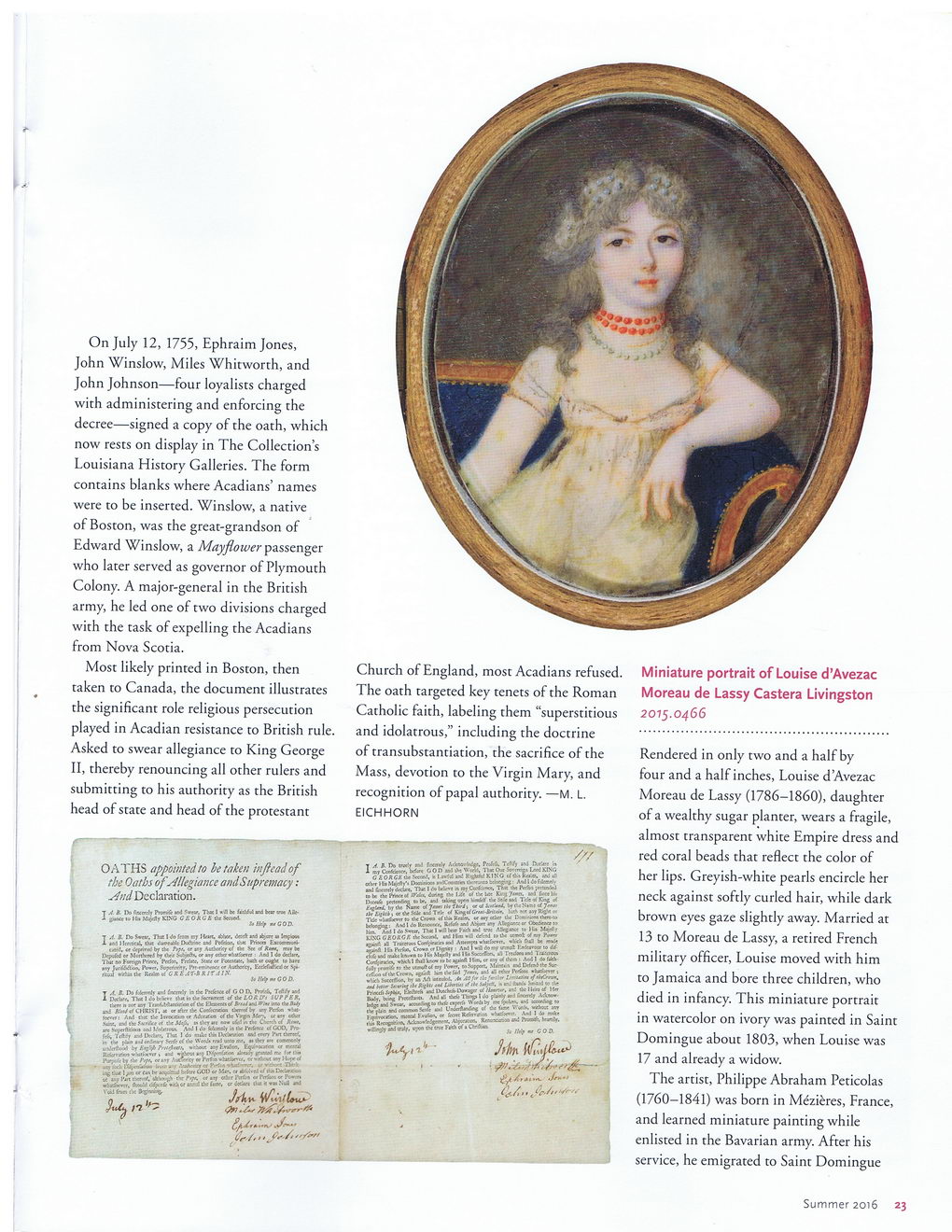This text was obtained via automated optical character recognition.
It has not been edited and may therefore contain several errors.
On July 12, 1755, Ephraim Jones, John Winslow, Miles Whitworth, and John Johnson—four loyalists charged with administering and enforcing the decree—signed a copy of the oath, which now rests on display in The Collection’s Louisiana History Galleries. The form contains blanks where Acadians’ names were to be inserted. Winslow, a native of Boston, was the great-grandson of Edward Winslow, a Mayflower passenger who later served as governor of Plymouth Colony. A major-general in the British army, he led one of two divisions charged with the task of expelling the Acadians from Nova Scotia. Most likely printed in Boston, then taken to Canada, the document illustrates the significant role religious persecution played in Acadian resistance to British rule. Asked to swear allegiance to King George II, thereby renouncing all other rulers and submitting to his authority as the British head of state and head of the protestant OATHS appointed to betaken infteadof the Oaths o f Allegiance and Supremacy : j4nd Declaration. A B. Do fiiKerely Promiic and Swear, That I will be Willful and bear mie Allegiance io I!u Mytfly KING GEORGE the Second. ^ k/COD T A. B. Do Swear, That 1 do from my Heart, abhor, deleft and allure «Impow 1 and I lereticaS, that <lurn*Mt Doctrine end Politioo, ih« Princes Excommunicated, or deprived bjr ihe Py/, or any Authority of the See of Rmt, may be Depofed or Murtheted by their Subjects or any oiher wtulfoefer : Abo I do declare, Tim no Foreign Prinee, Perfon, Prelaw, Stale or Potentate, huh or ooght to hare any Jurittaion, Powrr, Superiority, Pre-eminence of Authority, luelefufticaS Or Sf*. riuil withintbe Realm of GR EAT-BR St Ihlf mtGOD. r A. B. Do foknwly and fincerely in the Prefcxe cfGOD, Prrfifi, Trfify and i Declare That I rfo believe that m the Sacrament of the LOR Eft SUPPER, £5e£ Mr «nr of the of Brud and Wim into the BU, and Bind of CHRIST, at or after the Contcmion thereof by any Perfon whatever: And that the Invocation or Adoraton of the ' or any other Saint, and the Sacrifice of the AUfi, a, they are now u« n are Supe.ftrao.* and Ji'oiarrow. And 1 do fe!emniy « the l’rcfcnce ofGOP.Pro-f'k ’Uft.ly and Declare, Thai I do make tHu Declaration and erery Part thereef. in the plain aivf ordinary Sente of t!ie WorJa read otKo me, a» they are commonly u*ierflo«>d by E’gt'fi Prtn,Uai, without any h*afion, &}U!»<xat«i « »«ul Refcrvation whufocver , and wihosst any IHpen£u»n alfosy gr«Md me Purpofe by the Piff, orany AwSority orPerfrnwfcatlbm/, txw«te« any Hr**of . • tYf it., i...., '-jiKori'T or Perfcn what!S“*er, v W — . Tar* ’ ____ h-fer, COD or Ma% or abtairerf of di Declarant i or Powfti Hsiifiltw,' StiiiMd^rJii^ Hw- er declare ika « wa*Null and Void (rum tSe Beginning. inc that 1 am or can be acquittsd before CODor Ma% m aKonrcd efthnDeclj o’ any Pan thereof,' although tSt Ptft, orany other Perfofl «Perlo«orf whaiforwr, HwniW <lifp.r* Ki!h of LHc fjnK’ 'J:C ” " w1' Jpiyn Church of England, most Acadians refused. The oath targeted key tenets of the Roman Catholic faith, labeling them “superstitious and idolatrous,” including the doctrine of transubstantiation, the sacrifice of the Mass, devotion to the Virgin Mary, and recognition of papal authority. —M. L. EICHHORN _ > B rv, rrue!» ami lincsrely Acknowledge, ProWi, Teilify aivl Declare in I irr Confciener, before G O D and l>* Wortd, That Oar Swrteta# Urd KING GEORGE tbeSwtjnd, nl-awfal and Htglwful KIN G oftKtSaA, and ail oiher I la MaWW’a DocniniOM areKTewswiei thereunto brtonjr.ij -. And I to fatemnly and fineerelrtolr*. That I do be&ve m my Coofcienee, TMt ih: Perfoa wsteoded to be the Prince of iMh dun'g ,l* *“ ^ wrtendiftK to be, and taking upon Simfcif the Stile aod Ti.le ot Kmg of bT the^ame ofjnxi lb, or of S<*rW, by theNamc ibf Eirili t ot the Stile and Tale of Kif>gofCr<J/-flr.Wi, liiihiiMt a-iy Rgt or Tale “tefoever to the Crown of that Realm, or wy other *e DsmrBwatheTt-to I *> Refrfe »d Abwrr any Afcg-n* or 0*6**?t » 1 do Swear, That I will tor Kahh and true Alkffioee to H» Majefty M\G GEORGE the Second, and Him will defM t»(be * "T : awinft an Traaerous Confpraciet and Attemett wtatfoever, wteh fe.1 te tn*J "^•a j»;, u.ffon Crown or 0«n'*y : And 1 will do my trmoftI.ndea»oor to dif-aeaintt lii» rerwn, V 1 lit Soccefloo, ail l reifona ami Iraiterou* ///' GOD. Jtfai Muiy As-< Miniature portrait of Louise d’Avezac Moreau de Lassy Castera Livingston 2015.0466 Rendered in only two and a half by four and a half inches, Louise d’Avezac Moreau de Lassy (1786-1860), daughter of a wealthy sugar planter, wears a fragile, almost transparent white Empire dress and red coral beads that reflect the color of her lips. Greyish-white pearls encircle her neck against softly curled hair, while dark brown eyes gaze slightly away. Married at 13 to Moreau de Lassy, a retired French military officer, Louise moved with him to Jamaica and bore three children, who died in infancy. This miniature portrait in watercolor on ivory was painted in Saint Domingue about 1803, when Louise was 17 and already a widow. The artist, Philippe Abraham Peticolas (1760-1841) was bom in Mezieres, France, and learned miniature painting while enlisted in the Bavarian army. After his service, he emigrated to Saint Domingue Summer 2016 23

New Orleans Quarterly 2016 Summer (020)